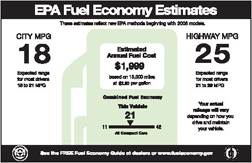EPA To Revise MPG Testing Procedures
 The Mini Cooper has become the latest in a line of vehicles whose makers have had to admit were overstating their fuel economy numbers. The 2014 model actually gets anywhere from one to four miles per gallon less than originally claimed. The BMW subsidiary’s error follows Mercedes-Benz, Ford, Hyundai, and Kia, all of which also have had to roll back their mileage claims.
The Mini Cooper has become the latest in a line of vehicles whose makers have had to admit were overstating their fuel economy numbers. The 2014 model actually gets anywhere from one to four miles per gallon less than originally claimed. The BMW subsidiary’s error follows Mercedes-Benz, Ford, Hyundai, and Kia, all of which also have had to roll back their mileage claims.
Meanwhile, many consumers' groups continue to complain that they’re routinely seeing real world numbers that lag what manufacturers post on their window stickers and use in their advertising. That’s leading to stricter enforcement and likely changes to testing procedures by the Environmental Protection Agency which oversees fuel economy regulations.
Part of the problem is that fuel economy can vary widely, depending upon factors such as climate, altitude, and driver behavior. But industry observers also fault EPA testing procedures – and the fact that manufacturers usually run their own tests for the under-staffed federal agency to then review.
The EPA has been increasing the number of audits it conducts since Ford and Hyundai/Kia mileage gaps were uncovered. And, by year-end, it intends to revise key elements of its testing.
The EPA has revised its mileage testing procedures on a number of occasions over the years, most recently in 2008. That last effort was particularly focused on hybrid-electric vehicles, such as the Toyota Prius, which often had some of the biggest gaps between rated and real-world mileage numbers.
 The Mini Cooper has become the latest in a line of vehicles whose makers have had to admit were overstating their fuel economy numbers. The 2014 model actually gets anywhere from one to four miles per gallon less than originally claimed. The BMW subsidiary’s error follows Mercedes-Benz, Ford, Hyundai, and Kia, all of which also have had to roll back their mileage claims.
The Mini Cooper has become the latest in a line of vehicles whose makers have had to admit were overstating their fuel economy numbers. The 2014 model actually gets anywhere from one to four miles per gallon less than originally claimed. The BMW subsidiary’s error follows Mercedes-Benz, Ford, Hyundai, and Kia, all of which also have had to roll back their mileage claims.